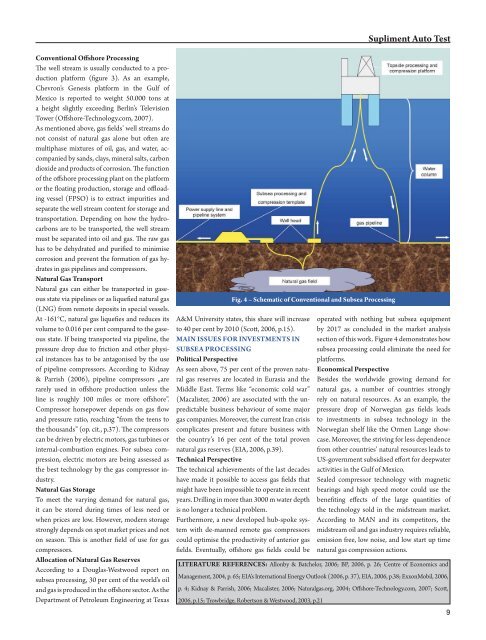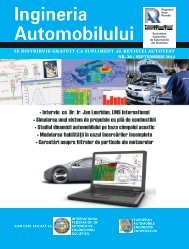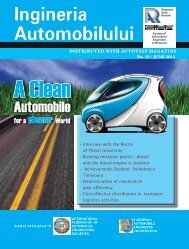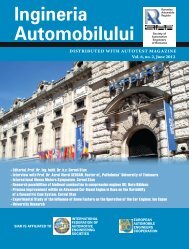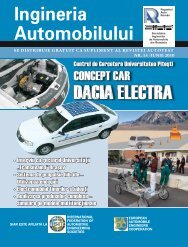automobilul modern - ingineria-automobilului.ro
automobilul modern - ingineria-automobilului.ro
automobilul modern - ingineria-automobilului.ro
You also want an ePaper? Increase the reach of your titles
YUMPU automatically turns print PDFs into web optimized ePapers that Google loves.
Conventional Off shore P<strong>ro</strong>cessing<br />
Th e well stream is usually conducted to a p<strong>ro</strong>duction<br />
platform (fi gure 3). As an example,<br />
Chev<strong>ro</strong>n’s Genesis platform in the Gulf of<br />
Mexico is reported to weight 50.000 tons at<br />
a height slightly exceeding Berlin’s Television<br />
Tower (Off shore-Technology.com, 2007).<br />
As mentioned above, gas fi elds’ well streams do<br />
not consist of natural gas alone but oft en are<br />
multiphase mixtures of oil, gas, and water, accompanied<br />
by sands, clays, mineral salts, carbon<br />
dioxide and p<strong>ro</strong>ducts of cor<strong>ro</strong>sion. Th e function<br />
of the off shore p<strong>ro</strong>cessing plant on the platform<br />
or the fl oating p<strong>ro</strong>duction, storage and offl oading<br />
vessel (FPSO) is to extract impurities and<br />
separate the well stream content for storage and<br />
transportation. Depending on how the hyd<strong>ro</strong>carbons<br />
are to be transported, the well stream<br />
must be separated into oil and gas. Th e raw gas<br />
has to be dehydrated and purifi ed to minimise<br />
cor<strong>ro</strong>sion and prevent the formation of gas hydrates<br />
in gas pipelines and compressors.<br />
Natural Gas Transport<br />
Natural gas can either be transported in gaseous<br />
state via pipelines or as liquefi ed natural gas<br />
(LNG) f<strong>ro</strong>m remote deposits in special vessels.<br />
At -161°C, natural gas liquefi es and reduces its<br />
volume to 0.016 per cent compared to the gaseous<br />
state. If being transported via pipeline, the<br />
pressure d<strong>ro</strong>p due to friction and other physical<br />
instances has to be antagonised by the use<br />
of pipeline compressors. According to Kidnay<br />
& Parrish (2006), pipeline compressors „are<br />
rarely used in off shore p<strong>ro</strong>duction unless the<br />
line is <strong>ro</strong>ughly 100 miles or more off shore”.<br />
Compressor horsepower depends on gas fl ow<br />
and pressure ratio, reaching “f<strong>ro</strong>m the teens to<br />
the thousands” (op. cit., p.37). Th e compressors<br />
can be driven by electric motors, gas turbines or<br />
internal-combustion engines. For subsea compression,<br />
electric motors are being assessed as<br />
the best technology by the gas compressor industry.<br />
Natural Gas Storage<br />
To meet the varying demand for natural gas,<br />
it can be stored during times of less need or<br />
when prices are low. However, <st<strong>ro</strong>ng>modern</st<strong>ro</strong>ng> storage<br />
st<strong>ro</strong>ngly depends on spot market prices and not<br />
on season. Th is is another fi eld of use for gas<br />
compressors.<br />
Allocation of Natural Gas Reserves<br />
According to a Douglas-Westwood report on<br />
subsea p<strong>ro</strong>cessing, 30 per cent of the world’s oil<br />
and gas is p<strong>ro</strong>duced in the off shore sector. As the<br />
Department of Pet<strong>ro</strong>leum Engineering at Texas<br />
Fig. 4 – Schematic of Conventional and Subsea P<strong>ro</strong>cessing<br />
A&M University states, this share will increase<br />
to 40 per cent by 2010 (Scott , 2006, p.15).<br />
MAIN ISSUES FOR INVESTMENTS IN<br />
SUBSEA PROCESSING<br />
Political Perspective<br />
As seen above, 75 per cent of the p<strong>ro</strong>ven natural<br />
gas reserves are located in Eurasia and the<br />
Middle East. Terms like “economic cold war”<br />
(Macalister, 2006) are associated with the unpredictable<br />
business behaviour of some major<br />
gas companies. Moreover, the current Iran crisis<br />
complicates present and future business with<br />
the country’s 16 per cent of the total p<strong>ro</strong>ven<br />
natural gas reserves (EIA, 2006, p.39).<br />
Technical Perspective<br />
Th e technical achievements of the last decades<br />
have made it possible to access gas fi elds that<br />
might have been impossible to operate in recent<br />
years. Drilling in more than 3000 m water depth<br />
is no longer a technical p<strong>ro</strong>blem.<br />
Furthermore, a new developed hub-spoke system<br />
with de-manned remote gas compressors<br />
could optimise the p<strong>ro</strong>ductivity of anterior gas<br />
fi elds. Eventually, off shore gas fi elds could be<br />
Supliment Auto Test<br />
operated with nothing but subsea equipment<br />
by 2017 as conclu ded in the market analysis<br />
section of this work. Figure 4 demonstrates how<br />
subsea p<strong>ro</strong>cessing could eliminate the need for<br />
platforms.<br />
Economical Perspective<br />
Besides the worldwide g<strong>ro</strong>wing demand for<br />
natural gas, a number of countries st<strong>ro</strong>ngly<br />
rely on natural resources. As an example, the<br />
pressure d<strong>ro</strong>p of Norwegian gas fi elds leads<br />
to investments in subsea technology in the<br />
Norwegian shelf like the Ormen Lange showcase.<br />
Moreover, the striving for less dependence<br />
f<strong>ro</strong>m other countries’ natural resources leads to<br />
US-government subsidised eff ort for deepwater<br />
activities in the Gulf of Mexico.<br />
Sealed compressor technology with magnetic<br />
bearings and high speed motor could use the<br />
benefi ting eff ects of the large quantities of<br />
the technology sold in the midstream market.<br />
According to MAN and its competitors, the<br />
midstream oil and gas industry requires reliable,<br />
emission free, low noise, and low start up time<br />
natural gas compression actions.<br />
LITERA TURE REFERENCES: Allonby & Batchelor, 2006; BP, 2006, p. 26; Centre of Economics and<br />
Management, 2004, p. 65; EIA’s International Energy Outlook (2006, p. 37), EIA, 2006, p.38; ExxonMobil, 2006,<br />
p. 4; Kidnay & Parrish, 2006; Macalister, 2006; Naturalgas.org, 2004; Off shore-Technology.com, 2007; Scott ,<br />
2006, p.15; T<strong>ro</strong>wbridge, Robertson & Westwood, 2003, p.21<br />
9


